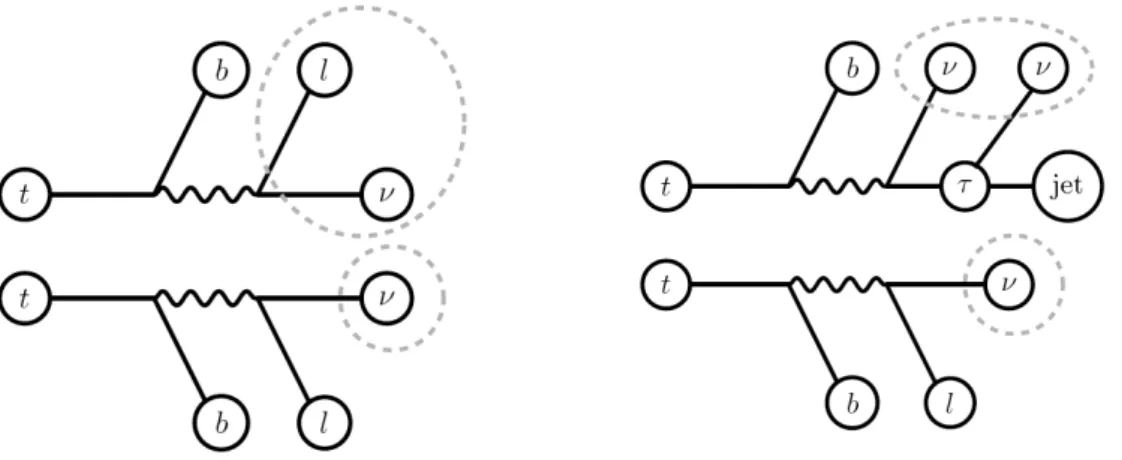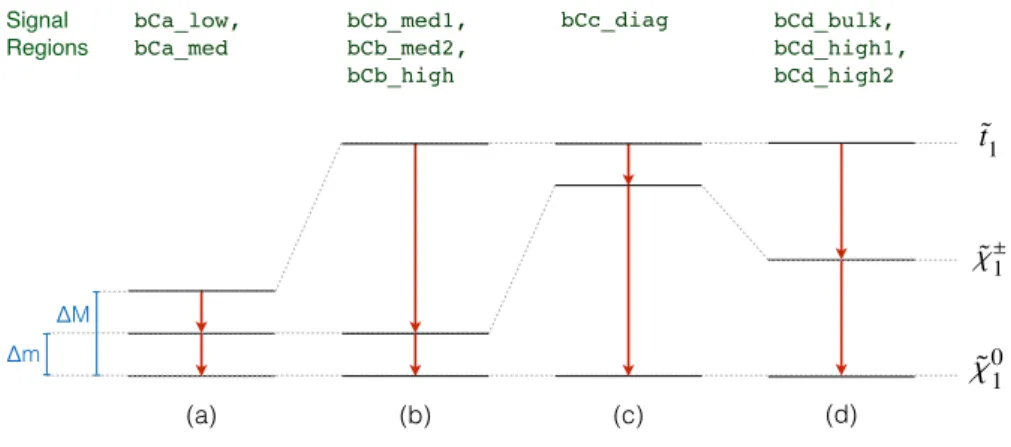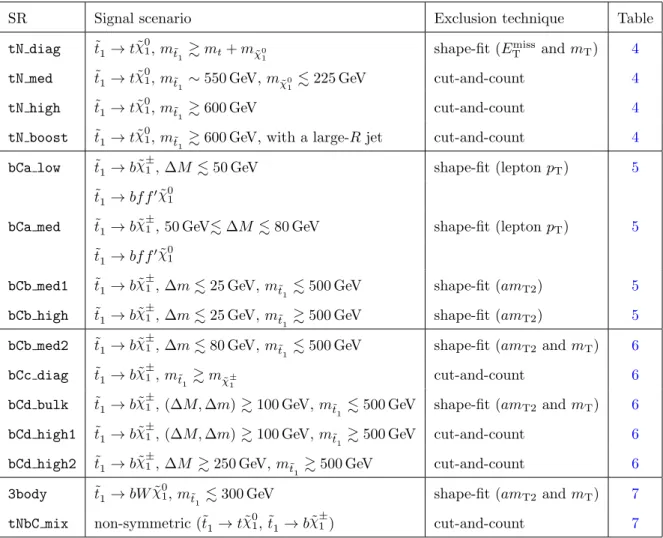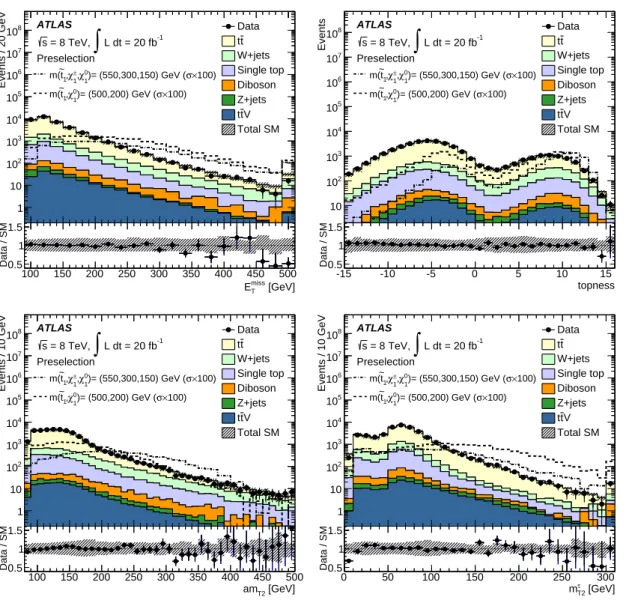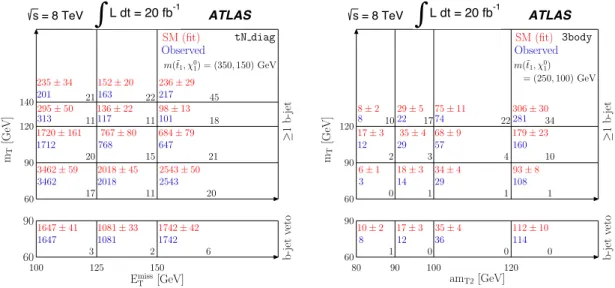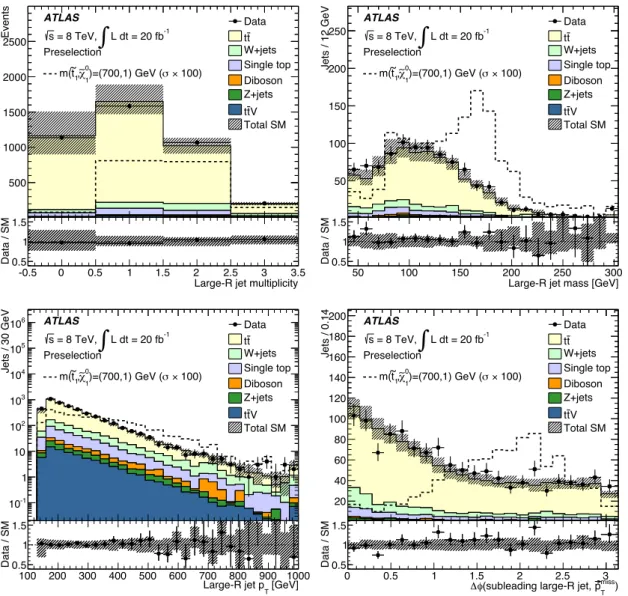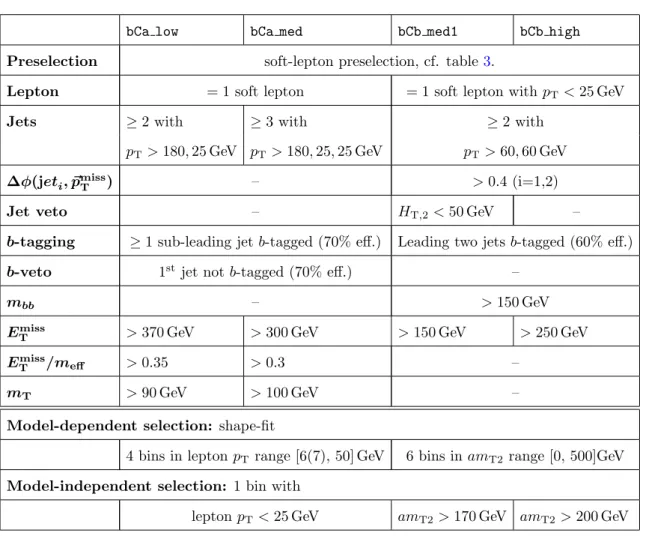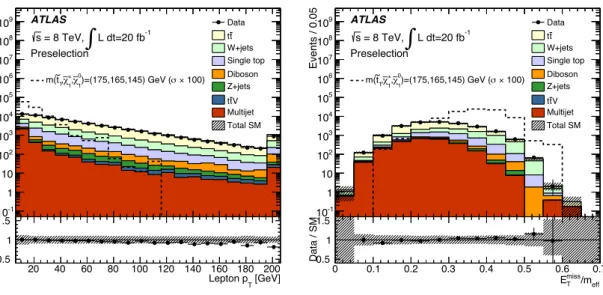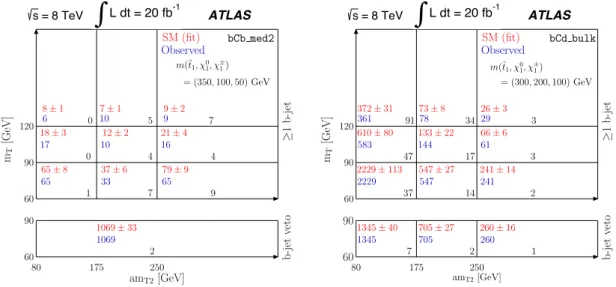EUROPEAN ORGANISATION FOR NUCLEAR RESEARCH (CERN)
CERN-PH-EP-2014-143
Submitted to: JHEP
Search for top squark pair production in final states with one
isolated lepton, jets, and missing transverse momentum in
√
s
= 8 TeV pp
collisions with the ATLAS detector
The ATLAS Collaboration
Abstract
The results of a search for top squark (stop) pair production in final states with one isolated lepton, jets, and missing transverse momentum are reported. The analysis is performed with proton–proton collision data at√s = 8 TeV collected with the ATLAS detector at the LHC in 2012 corresponding to an integrated luminosity of20 fb−1. The lightest supersymmetric particle (LSP) is taken to be the lightest neutralino which only interacts weakly and is assumed to be stable. The stop decay modes consid-ered are those to a top quark and the LSP as well as to a bottom quark and the lightest chargino, where the chargino decays to the LSP by emitting aW boson. A wide range of scenarios with differ-ent mass splittings between the stop, the lightest neutralino and the lightest chargino are considered, including cases where the W bosons or the top quarks are off-shell. Decay modes involving the heavier charginos and neutralinos are addressed using a set of phenomenological models of super-symmetry. No significant excess over the Standard Model prediction is observed. A stop with a mass between 210 and 640 GeV decaying directly to a top quark and a massless LSP is excluded at 95% confidence level, and in models where the mass of the lightest chargino is twice that of the LSP, stops are excluded at95% confidence level up to a mass of 500 GeV for an LSP mass in the range of 100 to 150 GeV. Stringent exclusion limits are also derived for all other stop decay modes considered, and model-independent upper limits are set on the visible cross-section for processes beyond the
Prepared for submission to JHEP
Search for top squark pair production in final states
with one isolated lepton, jets, and missing transverse
momentum in
√
s
= 8 TeV pp collisions with the
ATLAS detector
The ATLAS Collaboration
Abstract: The results of a search for top squark (stop) pair production in final states with one isolated lepton, jets, and missing transverse momentum are reported. The analysis is performed with proton–proton collision data at √s = 8 TeV collected with the ATLAS detector at the LHC in 2012 corresponding to an integrated luminosity of 20 fb−1. The lightest supersymmetric particle (LSP) is taken to be the lightest neutralino which only interacts weakly and is assumed to be stable. The stop decay modes considered are those to a top quark and the LSP as well as to a bottom quark and the lightest chargino, where the chargino decays to the LSP by emitting a W boson. A wide range of scenarios with different mass splittings between the stop, the lightest neutralino and the lightest chargino are considered, including cases where the W bosons or the top quarks are off-shell. Decay modes involving the heavier charginos and neutralinos are addressed using a set of phenomenological models of supersymmetry. No significant excess over the Standard Model prediction is observed. A stop with a mass between 210 and 640 GeV decaying directly to a top quark and a massless LSP is excluded at 95% confidence level, and in models where the mass of the lightest chargino is twice that of the LSP, stops are excluded at 95% confidence level up to a mass of 500 GeV for an LSP mass in the range of 100 to 150 GeV. Stringent exclusion limits are also derived for all other stop decay modes considered, and model-independent upper limits are set on the visible cross-section for processes beyond the Standard Model.
Contents
1 Introduction 2
2 Analysis strategy 4
3 The ATLAS detector 5
4 Trigger and data collection 6
5 Simulated samples 7
5.1 Background samples 8
5.2 Signal samples 8
6 Physics object reconstruction and discriminating variables 10
6.1 Physics object reconstruction 10
6.2 Tools to discriminate signal from background 14
7 Signal selections 16
7.1 Event preselection 17
7.2 Selections for the ˜t1 → t ˜χ01 decay 18
7.3 Selections for the ˜t1 → b ˜χ±1 decay 21
7.4 Selections for the mixed, three- and four-body decays 27
8 Background estimates 28
8.1 Control regions 29
8.2 Validation 32
9 Systematic uncertainties 36
10 Results 39
11 Summary and conclusions 45
12 Acknowledgements 47
A Detailed description of the discriminating variables 62
1 Introduction
The hierarchy problem [1–4] has gained additional attention with the observation of a new particle consistent with the Standard Model (SM) Higgs boson [5,6] at the LHC [7]. Super-symmetry (SUSY) [8–16], which extends the SM by introducing supersymmetric partners for all SM particles, provides an elegant solution to the hierarchy problem. The partner particles have identical quantum numbers except for a half-unit difference in spin. The superpartners of the left- and right-handed top quarks, ˜tL and ˜tR, mix to form the two mass eigenstates ˜t1 and ˜t2, where ˜t1 (top squark or stop) is the lighter one. If the super-symmetric partners of the top quarks have masses . 1 TeV, loop diagrams involving top quarks, which are the dominant contribution to the divergence of the Higgs boson mass, can be largely cancelled [17–24]. Significant mass splitting between ˜t1 and ˜t2 is possible due to the large top Yukawa coupling1. Furthermore, effects of the renormalisation group
equations are strong for the third generation squarks, usually driving their masses signifi-cantly lower than those of the other generations. These considerations suggest a light stop which, together with the stringent LHC limits excluding other coloured supersymmetric particles up to masses at the TeV level, motivates dedicated stop searches.
SUSY models can violate the conservation of baryon number and lepton number, re-sulting in a proton lifetime shorter than current experimental limits [25]. This is commonly solved by introducing a multiplicative quantum number called R-parity, which is 1 and−1 for all SM and SUSY particles, respectively. A generic R-parity-conserving minimal su-persymmetric extension of the SM (MSSM) [17, 26–29] predicts pair production of SUSY particles and the existence of a stable lightest supersymmetric particle (LSP). In a large variety of SUSY models, the lightest neutralino2 ( ˜χ0
1) is the LSP, which is also the
assump-tion throughout this paper. Since the ˜χ01 interacts only weakly it is a candidate for dark
matter.
The stop can decay into a variety of final states, depending amongst other things on the SUSY particle mass spectrum, in particular on the masses of the stop and the lightest neutralino. Figure1illustrates the simplest decay modes as a function of the stop and LSP masses. In the rightmost wedge, the stop mass is greater than the sum of the top quark and the LSP masses, hence the decay ˜t1 → t ˜χ01 is kinematically allowed. A lighter stop can undergo a three-body decay ˜t1→ bW ˜χ01 if the stop mass is still above the b + W + ˜χ01
mass. For an even lighter stop, the decay proceeds via a four-body process ˜t1 → bff0χ˜01, where f and f0 are two distinct fermions, or flavour-changing neutral current (FCNC) processes, such as the loop-suppressed ˜t1 → c ˜χ01. If supersymmetric particles other than
the ˜χ01 are lighter than the stop, then additional decay modes can open up. The stop
decay to a bottom quark and the lightest chargino (˜t1 → b ˜χ±1) is an important example,
1The masses of the ˜t
1 and ˜t2 are given by the eigenvalues of the stop mass matrix. The stop mass
matrix involves the top-quark Yukawa coupling in the off-diagonal elements, which typically induces a large mass splitting. The stop mass matrix is diagonalised by the stop mixing matrix, which gives the ˜tLand ˜tR
components of the mass eigenstates ˜t1and ˜t2. 2The charginos ˜χ±
1,2and neutralinos ˜χ01,2,3,4are the mass eigenstates formed from the linear superposition
of the charged and neutral SUSY partners of the Higgs and electroweak gauge bosons (higgsinos, winos and binos).
[GeV] [GeV] 0 100 200 300 100 m(t) Δm > m(t) m(W)+m(b) Δm > m(W)+m(b)
1 Introduction
m = m(˜t1) m( ˜01) m( ˜01) m(˜t1) ˜t1! t + ˜01 ˜t1! b + ˜± 1 ˜t1! b + W + ˜01 ˜t1! b + W⇤+ ˜0 1 ˜t1! c + ˜01 11 Introduction
m = m(˜t1) m( ˜01) m( ˜01) m(˜t1) ˜t1! t + ˜01 ˜t1! b + ˜±1 ˜t1! b + W + ˜01 ˜t1! b + W⇤+ ˜01 ˜t1! c + ˜01 11 Introduction
m = m(˜t1) m( ˜01) m( ˜01) m(˜t1) ˜t1! t + ˜01 ˜t1! b + ˜±1 ˜t1! b + W + ˜01 ˜t1! b + W⇤+ ˜01 ˜t1! c + ˜011 Introduction
m(˜t1) < m( ˜01) m = m(˜t1) m( ˜01) m( ˜01) m(˜t1) ˜t1 ! t + ˜01 ˜t1 ! b + ˜± 1 ˜t1 ! b + W + ˜01 ˜t1 ! b + W⇤+ ˜01 ˜t1 ! c + ˜01 0F
igu
re
1.
Ill
us
tr
at
ion
of
top
sq
uar
k
de
ca
y
m
od
es
in
th
e
m
as
s
pl
an
e
sp
an
ne
d
by
th
e
top
sq
uar
k
(˜t
1)
an
d
ligh
te
st
ne
ut
ral
in
o
(˜
0 1),
w
he
re
th
e
lat
te
r
is
as
su
m
ed
to
be
th
e
ligh
te
st
su
pe
rs
ym
m
et
ric
par
tic
le
.
le
ft/r
igh
t
st
op
m
ix
in
g
an
d
th
e
ne
ut
ral
in
o/c
har
gi
no
se
ct
or
.
Not
e
th
at
th
e
LE
P
lo
we
r
lim
it
1on
th
e
ligh
te
st
ch
ar
gi
no
m
as
s
(m
(˜
±1)
>
103
.5
G
eV
at
95%
con
fid
en
ce
le
ve
l [
25
])
im
plies
2th
at
th
e
˜t
1!
b
˜
±1de
ca
y
is
ki
ne
m
at
ic
al
ly
op
en
on
ly
if
th
e
st
op
m
as
s
is
ab
ov
e
th
is
lim
it.
3LHC
se
ar
ch
es
for
el
ec
tr
ow
eak
pr
od
uc
tion
of
ch
ar
gi
no
an
d
ne
ut
ral
in
o
pai
rs
(˜
±1˜
0 2) c
an
pu
sh
4th
e
m
as
s
lim
it
up
to
ab
ou
t
700
G
eV
(s
ee
for
ex
am
pl
e
R
ef
. [
26
]).
Ho
we
ve
r,
th
es
e
st
rin
ge
nt
5lim
its
de
pe
nd
up
on
as
su
m
pt
ion
s
w
hi
ch
m
ax
im
ise
th
e
se
ar
ch
se
ns
iti
vi
ty
,
su
ch
as
a
de
ca
y
6m
od
e
vi
a
sle
pt
on
s,
a
lo
w
-m
as
s
˜
01, an
d
ne
ar
ly
m
as
s-
de
ge
ne
rat
e
˜
±1˜
02st
at
es
w
ith
th
e
fie
ld
7con
te
nt
se
t
to
yi
el
d
a
hi
gh
pr
od
uc
tion
cr
os
s
se
ct
ion
.
8T
hi
s
ar
tic
le
pr
es
en
ts
a
se
ar
ch
for
di
re
ct
˜t
1pai
r
pr
od
uc
tion
in
fin
al
st
at
es
w
ith
on
e
9isol
at
ed
le
pt
on
(e
le
ct
ron
or
m
uon
1),
se
ve
ral
je
ts
, an
d
a
sign
ifi
can
t am
ou
nt
of
m
iss
in
g
tr
an
s-10ve
rs
e
m
om
en
tu
m
(t
he
m
agn
itu
de
of
w
hi
ch
is
re
fe
rr
ed
to
as
E
miss T).
T
he
pot
en
tial
ly
lar
ge
11E
miss Tis
ge
ne
rat
ed
by
th
e
tw
o
un
de
te
ct
ed
LS
Ps
an
d
ne
ut
rin
o(
s)
.
Al
l
top
sq
uar
k
de
ca
y
12sc
en
ar
ios
de
sc
rib
ed
ab
ov
e
ex
ce
pt
for
th
e
fla
vou
r-
ch
an
gi
ng
m
od
es
ar
e
con
sid
er
ed
.
He
av
y
13fla
vou
r
taggi
ng
in
for
m
at
ion
is
ut
ili
se
d
in
th
e
ev
en
t
se
le
ct
ion
s,
an
d
for
con
st
ru
ct
in
g
ki
ne
-14m
at
ic
var
iab
le
s.
T
he
se
ar
ch
for
a
he
av
y
st
op
ex
pl
oi
ts
a
de
di
cat
ed
te
ch
ni
qu
e
of
lar
ge
-r
ad
iu
s
15(lar
ge
-R
)
je
ts
.
Fu
rt
he
rm
or
e,
lo
w
-m
om
en
tu
m
le
pt
on
s
(r
ef
er
re
d
to
as
sof
t-le
pt
on
s)
ar
e
re
-16con
st
ru
ct
ed
an
d
id
en
tifi
ed
to
en
han
ce
th
e
se
ns
iti
vi
ty
to
se
ar
ch
for
˜t
1!
b
˜
±1deca
ys
with
17ne
ar
ly
m
as
s-
de
ge
ne
rat
e
˜
01an
d
˜
±1st
at
es
.
18Se
ar
ch
es
for
di
re
ct
˜t
1pai
r p
ro
du
ct
ion
ha
ve
pr
ev
iou
sly
be
en
re
por
te
d
by
th
e A
T
LAS
[
27
–
1932
] an
d
C
M
S
[
33
–
36
] c
ol
lab
or
at
ion
s,
as
we
ll
as
by
th
e
C
D
F
an
d
D
Ø
col
lab
or
at
ion
ss
as
-20suming
di
↵e
re
nt
SUS
Y
m
as
s
sp
ec
tr
a
an
d
de
ca
y
m
od
es
(s
ee
for
ex
am
pl
e
R
ef
s.
[
37
,
38
]).
21In
di
re
ct
se
ar
ch
es
for
st
op
s,
m
ed
iat
ed
by
gl
ui
no
pai
r p
ro
du
ct
ion
, h
av
e
be
en
re
por
te
d
by
th
e
22AT
LAS
[
39
–
43
] an
d
C
M
S
[
44
] c
ol
lab
or
at
ion
s.
23˜t
1!
t˜
0 1 1˜t
1!
b
˜
±1 2 1El ectro nsan dm uons from tau deca ysare incl uded .–
3
–
˜t
1!
bW
˜
01 3˜t
1!
bf
f
0˜
01 4˜t
1!
c
˜
0 1 52
T
he
A
T
LA
S
de
te
ct
or
and
da
ta
sa
m
pl
es
6T
he
AT
LAS
ex
pe
rim
en
t
[
45
] i
s
a
m
ul
ti-
pu
rp
os
e
par
tic
le
ph
ys
ic
s
de
te
ct
or
w
ith
ne
ar
ly
4⇡
7co
ve
rage
in
sol
id
an
gl
e.
It
con
sis
ts
of
in
ne
r
tr
ac
ki
ng
de
vi
ce
s
(I
D
),
el
ec
tr
om
agn
et
ic
an
d
8had
ron
ic
cal
or
im
et
rie
s
an
d
a
m
uon
sp
ec
tr
om
et
er
(M
S)
w
ith
fou
r
su
pe
rc
on
du
ct
in
g
m
agn
et
9sy
st
em
s,
w
hi
ch
com
pr
ise
a
th
in
sol
en
oi
d
su
rr
ou
nd
in
g
th
e
ID
, an
d
a
bar
re
l an
d
tw
o
en
d-
cap
10tor
oi
ds
pr
ov
id
in
g
th
e
m
agn
et
ic
fie
ld
for
th
e
m
uon
sp
ec
tr
om
et
er
. T
he
ID
con
sis
ts
of
a
sil
ic
on
11pi
xe
l d
et
ec
tor
, a
sil
ic
on
m
ic
ros
tr
ip
de
te
ct
or
an
d
a
st
ra
w
tu
be
tr
ac
ke
r (
for
a
ps
eu
dor
ap
id
ity
2 12of
|⌘|
<
1.
9)
.
It
pr
ov
id
es
pr
ec
isi
on
tr
ac
ki
ng
an
d
m
om
en
tu
m
m
eas
ur
em
en
t
of
ch
ar
ge
d
13par
tic
le
s f
or
|⌘|
<
2.
5
an
d
al
lo
w
s e
ffi
cien
t b
-je
t i
de
nt
ifi
cat
ion
. Hi
gh
-gr
an
ul
ar
ity
liq
ui
d-
ar
gon
14(LAr
)
sam
pl
in
g
el
ec
tr
om
agn
et
ic
cal
or
im
et
er
s
co
ve
r
in
th
e
ps
eu
dor
ap
id
ity
ran
ge
|⌘|
<
3.
2.
15T
he
had
ron
ic
cal
or
im
et
er
sy
st
em
is
bas
ed
on
tw
o
di
↵e
re
nt
te
ch
nol
ogi
es
,
sc
in
til
lat
in
g-til
e
16sam
pl
in
g
cal
or
im
et
er
(|⌘
|
<
1.
7)
an
d
LAr
sam
pl
in
g
cal
or
im
et
er
(1
.5
<
|⌘|
<
4.
9)
.
T
he
17m
uon
sp
ec
tr
om
et
er
has
se
par
at
e
tr
igge
r
an
d
hi
gh
-p
re
ci
sion
tr
ac
ki
ng
ch
am
be
rs
, t
he
lat
te
r
18pr
ov
id
in
g
m
uon
id
en
tifi
cat
ion
an
d
m
om
en
tu
m
m
eas
ur
em
en
t
for
|⌘|
<
2.
7.
19T
he
dat
a
sam
pl
e
us
ed
in
th
is
an
al
ys
is
was
tak
en
du
rin
g
th
e
pe
rio
d
from
M
ar
ch
to
20D
ec
em
be
r
2012
w
ith
th
e
LHC
op
er
at
in
g
at
a
pp
ce
nt
re
-of
-m
as
s
en
er
gy
of
p s
=
8
Te
V
.
21Af
te
r
ap
pl
ic
at
ion
of
be
am
,
de
te
ct
or
an
d
dat
a-
qu
al
ity
re
qu
ire
m
en
ts
,
th
e
tot
al
in
te
gr
at
ed
22lu
m
in
os
ity
is
20.
3 f
b
1w
ith
an
un
ce
rt
ai
nt
y
of
±
2.
8%
.
T
he
un
ce
rt
ai
nt
y
is
de
riv
ed
fol
lo
w
in
g
23th
e
sam
e
m
et
ho
dol
ogy
as
th
at
de
tai
le
d
in
R
ef
. [
46
],
from
a
pr
el
im
in
ar
y
cal
ib
rat
ion
of
th
e
24lu
m
in
os
ity
sc
al
e
de
riv
ed
from
be
am
-s
ep
ar
at
ion
sc
an
s
pe
rfor
m
ed
in
No
ve
m
be
r
2012.
25T
he
dat
as
et
us
ed
for
th
is
an
al
ys
is
was
re
cor
de
d
us
in
g
th
ee
di
↵e
re
nt
ty
pe
s
of
tr
igge
rs
26bas
ed
on
re
qu
iri
ng
a
sin
gl
e-el
ec
tr
on
, a
sin
gl
e-m
uon
, or
lar
ge
E
missT. C
an
di
dat
e
ev
en
ts
in
th
e
27el
ec
tr
on
(m
uon
) c
han
ne
l ar
e
col
le
ct
ed
us
in
g
a
logi
cal
-O
R
com
bi
nat
ion
of
th
e
sin
gl
e-el
ec
tr
on
28(s
in
gl
e-m
uon
)
an
d
E
miss Ttr
igge
rs
.
T
he
sin
gl
e-
le
pt
on
tr
igge
rs
ha
ve
a
tr
an
sv
er
se
m
om
en
tu
m
29(p
T)
th
re
sh
ol
d
of
24
G
eV
. A
se
con
d
se
t
of
com
pl
em
en
tar
y
sin
gl
e-le
pt
on
tr
igge
rs
w
ith
p
T 30th
re
sh
ol
ds
at
60
G
eV
(36
G
eV
)
for
th
e
el
ec
tr
on
(m
uon
)
cas
e
re
co
ve
rs
sm
al
l
in
effi
ciencies
31as
so
ci
at
ed
w
ith
th
e
lo
we
r
th
re
sh
ol
d
sin
gl
e-
le
pt
on
tr
igge
rs
du
e
to
le
pt
on
isol
at
ion
cr
ite
ria.
32The
E
missTtr
igge
r
has
a
th
re
sh
ol
d
of
80
G
eV
an
d
re
ac
he
s
fu
ll
effi
ci
en
cy
for
ev
en
ts
w
ith
33o✏
ine
E
missTab
ov
e
150
G
eV
. D
ur
in
g
th
e
be
gi
nn
in
g
of
2012
dat
a
tak
in
g,
th
e
E
missTtr
igge
r
34was
par
tly
ke
pt
di
sab
le
d,
cau
sin
g
a
los
s
of
ab
ou
t
2 p
b
1in
in
te
gr
at
ed
lu
m
in
os
ity
.
T
he
35com
bi
ne
d
tr
igge
r
effi
ciency
is
>
98%
for
th
e
le
pt
on
an
d
E
missTse
le
ct
ion
cr
ite
ria
ap
pl
ie
d
1in
th
e
an
al
ys
is.
For
th
e
sof
t-le
pt
on
se
le
ct
ion
s,
th
e
sin
gl
e-
le
pt
on
tr
igge
r
th
re
sh
ol
ds
ar
e
to
o
2lar
ge
re
nd
er
in
g
th
es
e
tr
igge
rs
us
el
es
s.
Al
l c
an
di
dat
e
ev
en
ts
ar
e
th
er
ef
or
e
re
cor
de
d
us
in
g
3 2 AT LA Sus esa right -han ded coord inat esy stem with its origi nat the nom inal inte ract ion poin tin the ntre of th ede tect oran dth e z-axis along the beam pipe . C ylin drica l coo rdin ates (r, )are used inth e vers epl ane, bein gth eaz imut hal a ngle aro und the beam pipe . T he pseu dora pidi ty ⌘ isdefi ned in ofth epo lar angl e✓ by ⌘= lntan (✓/2), and R= p ( ⌘) 2 + ( )2–
4
–
˜t
1!
bW
˜
01 3˜t
1!
bf
f
0˜
01 4˜t
1!
c
˜
0 1 52
T
he
A
T
LA
S
de
te
ct
or
and
da
ta
sa
m
pl
es
6T
he
AT
LAS
ex
pe
rim
en
t
[
45
] i
s
a
m
ul
ti-
pu
rp
os
e
par
tic
le
ph
ys
ic
s
de
te
ct
or
w
ith
ne
ar
ly
4⇡
7co
ve
rage
in
sol
id
an
gl
e.
It
con
sis
ts
of
in
ne
r
tr
ac
ki
ng
de
vi
ce
s
(I
D
),
el
ec
tr
om
agn
et
ic
an
d
8had
ron
ic
cal
or
im
et
rie
s
an
d
a
m
uon
sp
ec
tr
om
et
er
(M
S)
w
ith
fou
r
su
pe
rc
on
du
ct
in
g
m
agn
et
9sy
st
em
s,
w
hi
ch
com
pr
ise
a
th
in
sol
en
oi
d
su
rr
ou
nd
in
g
th
e
ID
, an
d
a
bar
re
l an
d
tw
o
en
d-
cap
10tor
oi
ds
pr
ov
id
in
g
th
e
m
agn
et
ic
fie
ld
for
th
e
m
uon
sp
ec
tr
om
et
er
. T
he
ID
con
sis
ts
of
a
sil
ic
on
11pi
xe
l d
et
ec
tor
, a
sil
ic
on
m
ic
ros
tr
ip
de
te
ct
or
an
d
a
st
ra
w
tu
be
tr
ac
ke
r (
for
a
ps
eu
dor
ap
id
ity
2 12of
|⌘|
<
1.
9)
.
It
pr
ov
id
es
pr
ec
isi
on
tr
ac
ki
ng
an
d
m
om
en
tu
m
m
eas
ur
em
en
t
of
ch
ar
ge
d
13par
tic
le
s f
or
|⌘|
<
2.
5
an
d
al
lo
w
s e
ffi
cien
t b
-je
t i
de
nt
ifi
cat
ion
. Hi
gh
-gr
an
ul
ar
ity
liq
ui
d-
ar
gon
14(LAr
)
sam
pl
in
g
el
ec
tr
om
agn
et
ic
cal
or
im
et
er
s
co
ve
r
in
th
e
ps
eu
dor
ap
id
ity
ran
ge
|⌘|
<
3.
2.
15T
he
had
ron
ic
cal
or
im
et
er
sy
st
em
is
bas
ed
on
tw
o
di
↵e
re
nt
te
ch
nol
ogi
es
,
sc
in
til
lat
in
g-til
e
16sam
pl
in
g
cal
or
im
et
er
(|⌘
|
<
1.
7)
an
d
LAr
sam
pl
in
g
cal
or
im
et
er
(1
.5
<
|⌘|
<
4.
9)
.
T
he
17m
uon
sp
ec
tr
om
et
er
has
se
par
at
e
tr
igge
r
an
d
hi
gh
-p
re
ci
sion
tr
ac
ki
ng
ch
am
be
rs
, t
he
lat
te
r
18pr
ov
id
in
g
m
uon
id
en
tifi
cat
ion
an
d
m
om
en
tu
m
m
eas
ur
em
en
t
for
|⌘|
<
2.
7.
19T
he
dat
a
sam
pl
e
us
ed
in
th
is
an
al
ys
is
was
tak
en
du
rin
g
th
e
pe
rio
d
from
M
ar
ch
to
20D
ec
em
be
r
2012
w
ith
th
e
LHC
op
er
at
in
g
at
a
pp
ce
nt
re
-of
-m
as
s
en
er
gy
of
p s
=
8
Te
V
.
21Af
te
r
ap
pl
ic
at
ion
of
be
am
,
de
te
ct
or
an
d
dat
a-
qu
al
ity
re
qu
ire
m
en
ts
,
th
e
tot
al
in
te
gr
at
ed
22lu
m
in
os
ity
is
20.
3 f
b
1w
ith
an
un
ce
rt
ai
nt
y
of
±
2.
8%
.
T
he
un
ce
rt
ai
nt
y
is
de
riv
ed
fol
lo
w
in
g
23th
e
sam
e
m
et
ho
dol
ogy
as
th
at
de
tai
le
d
in
R
ef
. [
46
],
from
a
pr
el
im
in
ar
y
cal
ib
rat
ion
of
th
e
24lu
m
in
os
ity
sc
al
e
de
riv
ed
from
be
am
-s
ep
ar
at
ion
sc
an
s
pe
rfor
m
ed
in
No
ve
m
be
r
2012.
25T
he
dat
as
et
us
ed
for
th
is
an
al
ys
is
was
re
cor
de
d
us
in
g
th
ee
di
↵e
re
nt
ty
pe
s
of
tr
igge
rs
26bas
ed
on
re
qu
iri
ng
a
sin
gl
e-el
ec
tr
on
, a
sin
gl
e-m
uon
, or
lar
ge
E
missT. C
an
di
dat
e
ev
en
ts
in
th
e
27el
ec
tr
on
(m
uon
) c
han
ne
l ar
e
col
le
ct
ed
us
in
g
a
logi
cal
-O
R
com
bi
nat
ion
of
th
e
sin
gl
e-el
ec
tr
on
28(s
in
gl
e-m
uon
)
an
d
E
miss Ttr
igge
rs
.
T
he
sin
gl
e-
le
pt
on
tr
igge
rs
ha
ve
a
tr
an
sv
er
se
m
om
en
tu
m
29(p
T)
th
re
sh
ol
d
of
24
G
eV
. A
se
con
d
se
t
of
com
pl
em
en
tar
y
sin
gl
e-le
pt
on
tr
igge
rs
w
ith
p
T 30th
re
sh
ol
ds
at
60
G
eV
(36
G
eV
)
for
th
e
el
ec
tr
on
(m
uon
)
cas
e
re
co
ve
rs
sm
al
l
in
effi
ciencies
31as
so
ci
at
ed
w
ith
th
e
lo
we
r
th
re
sh
ol
d
sin
gl
e-
le
pt
on
tr
igge
rs
du
e
to
le
pt
on
isol
at
ion
cr
ite
ria.
32The
E
missTtr
igge
r
has
a
th
re
sh
ol
d
of
80
G
eV
an
d
re
ac
he
s
fu
ll
effi
ci
en
cy
for
ev
en
ts
w
ith
33o✏
ine
E
missTab
ov
e
150
G
eV
. D
ur
in
g
th
e
be
gi
nn
in
g
of
2012
dat
a
tak
in
g,
th
e
E
missTtr
igge
r
34was
par
tly
ke
pt
di
sab
le
d,
cau
sin
g
a
los
s
of
ab
ou
t
2 p
b
1in
in
te
gr
at
ed
lu
m
in
os
ity
.
T
he
35com
bi
ne
d
tr
igge
r
effi
ciency
is
>
98%
for
th
e
le
pt
on
an
d
E
missTse
le
ct
ion
cr
ite
ria
ap
pl
ie
d
1in
th
e
an
al
ys
is.
For
th
e
sof
t-le
pt
on
se
le
ct
ion
s,
th
e
sin
gl
e-le
pt
on
tr
igge
r
th
re
sh
ol
ds
ar
e
to
o
2lar
ge
re
nd
er
in
g
th
es
e
tr
igge
rs
us
el
es
s.
Al
l c
an
di
dat
e
ev
en
ts
ar
e
th
er
ef
or
e
re
cor
de
d
us
in
g
2 AT LAS uses arig ht-h ande dco ord inat esy stem with its origi nat the nom inal inte ract ion poin tin the ofth ede tect or an dth e z-axis along the beam pipe . C ylin drica l coo rdin ates (r, )are used inth e epl ane, bein gth eaz imut hal a ngle aro und the beam pipe . T heps eudo rapi dity ⌘is defi ned in pola ran gle ✓by ⌘= lntan (✓/2), and R= p ( ⌘) 2 + ( )2–
4
–
˜t
1!
bW
˜
01 3˜t
1!
bf
f
0˜
01 4˜t
1!
c
˜
0 1 52
T
he
A
T
LA
S
de
te
ct
or
and
da
ta
sa
m
pl
es
6T
he
AT
LAS
ex
pe
rim
en
t
[
45
] i
s
a
m
ul
ti-
pu
rp
os
e
par
tic
le
ph
ys
ic
s
de
te
ct
or
w
ith
ne
ar
ly
4⇡
7co
ve
rage
in
sol
id
an
gl
e.
It
con
sis
ts
of
in
ne
r
tr
ac
ki
ng
de
vi
ce
s
(I
D
),
el
ec
tr
om
agn
et
ic
an
d
8had
ron
ic
cal
or
im
et
rie
s
an
d
a
m
uon
sp
ec
tr
om
et
er
(M
S)
w
ith
fou
r
su
pe
rc
on
du
ct
in
g
m
agn
et
9sy
st
em
s,
w
hi
ch
com
pr
ise
a
th
in
sol
en
oi
d
su
rr
ou
nd
in
g
th
e
ID
, an
d
a
bar
re
l an
d
tw
o
en
d-
cap
10tor
oi
ds
pr
ov
id
in
g
th
e
m
agn
et
ic
fie
ld
for
th
e
m
uon
sp
ec
tr
om
et
er
. T
he
ID
con
sis
ts
of
a
sil
ic
on
11pi
xe
l d
et
ec
tor
, a
sil
ic
on
m
ic
ros
tr
ip
de
te
ct
or
an
d
a
st
ra
w
tu
be
tr
ac
ke
r (
for
a
ps
eu
dor
ap
id
ity
2 12of
|⌘|
<
1.
9)
.
It
pr
ov
id
es
pr
ec
isi
on
tr
ac
ki
ng
an
d
m
om
en
tu
m
m
eas
ur
em
en
t
of
ch
ar
ge
d
13par
tic
le
s f
or
|⌘|
<
2.
5
an
d
al
lo
w
s e
ffi
cien
t b
-je
t i
de
nt
ifi
cat
ion
. Hi
gh
-gr
an
ul
ar
ity
liq
ui
d-
ar
gon
14(LAr
)
sam
pl
in
g
el
ec
tr
om
agn
et
ic
cal
or
im
et
er
s
co
ve
r
in
th
e
ps
eu
dor
ap
id
ity
ran
ge
|⌘|
<
3.
2.
15T
he
had
ron
ic
cal
or
im
et
er
sy
st
em
is
bas
ed
on
tw
o
di
↵e
re
nt
te
ch
nol
ogi
es
,
sc
in
til
lat
in
g-til
e
16sam
pl
in
g
cal
or
im
et
er
(|⌘
|
<
1.
7)
an
d
LAr
sam
pl
in
g
cal
or
im
et
er
(1
.5
<
|⌘|
<
4.
9)
.
T
he
17m
uon
sp
ec
tr
om
et
er
has
se
par
at
e
tr
igge
r
an
d
hi
gh
-p
re
ci
sion
tr
ac
ki
ng
ch
am
be
rs
, t
he
lat
te
r
18pr
ov
id
in
g
m
uon
id
en
tifi
cat
ion
an
d
m
om
en
tu
m
m
eas
ur
em
en
t
for
|⌘|
<
2.
7.
19T
he
dat
a
sam
pl
e
us
ed
in
th
is
an
al
ys
is
was
tak
en
du
rin
g
th
e
pe
rio
d
from
M
ar
ch
to
20D
ec
em
be
r
2012
w
ith
th
e
LHC
op
er
at
in
g
at
a
pp
ce
nt
re
-of
-m
as
s
en
er
gy
of
p s
=
8
Te
V
.
21Af
te
r
ap
pl
ic
at
ion
of
be
am
,
de
te
ct
or
an
d
dat
a-qu
al
ity
re
qu
ire
m
en
ts
,
th
e
tot
al
in
te
gr
at
ed
22lu
m
in
os
ity
is
20.
3 f
b
1w
ith
an
un
ce
rt
ai
nt
y
of
±
2.
8%
.
T
he
un
ce
rt
ai
nt
y
is
de
riv
ed
fol
lo
w
in
g
23th
e
sam
e
m
et
ho
dol
ogy
as
th
at
de
tai
le
d
in
R
ef
. [
46
],
from
a
pr
el
im
in
ar
y
cal
ib
rat
ion
of
th
e
24lu
m
in
os
ity
sc
al
e
de
riv
ed
from
be
am
-s
ep
ar
at
ion
sc
an
s
pe
rfor
m
ed
in
No
ve
m
be
r
2012.
25T
he
dat
as
et
us
ed
for
th
is
an
al
ys
is
was
re
cor
de
d
us
in
g
th
ee
di
↵e
re
nt
ty
pe
s
of
tr
igge
rs
26bas
ed
on
re
qu
iri
ng
a
sin
gl
e-el
ec
tr
on
, a
sin
gl
e-m
uon
, or
lar
ge
E
missT. C
an
di
dat
e
ev
en
ts
in
th
e
27el
ec
tr
on
(m
uon
) c
han
ne
l ar
e
col
le
ct
ed
us
in
g
a
logi
cal
-O
R
com
bi
nat
ion
of
th
e
sin
gl
e-el
ec
tr
on
28(s
in
gl
e-m
uon
)
an
d
E
miss Ttr
igge
rs
.
T
he
sin
gl
e-
le
pt
on
tr
igge
rs
ha
ve
a
tr
an
sv
er
se
m
om
en
tu
m
29(p
T)
th
re
sh
ol
d
of
24
G
eV
. A
se
con
d
se
t
of
com
pl
em
en
tar
y
sin
gl
e-le
pt
on
tr
igge
rs
w
ith
p
T 30th
re
sh
ol
ds
at
60
G
eV
(36
G
eV
)
for
th
e
el
ec
tr
on
(m
uon
)
cas
e
re
co
ve
rs
sm
al
l
in
effi
ciencies
31as
so
ci
at
ed
w
ith
th
e
lo
we
r
th
re
sh
ol
d
sin
gl
e-
le
pt
on
tr
igge
rs
du
e
to
le
pt
on
isol
at
ion
cr
ite
ria.
32The
E
missTtr
igge
r
has
a
th
re
sh
ol
d
of
80
G
eV
an
d
re
ac
he
s
fu
ll
effi
ci
en
cy
for
ev
en
ts
w
ith
33o✏
ine
E
missTab
ov
e
150
G
eV
. D
ur
in
g
th
e
be
gi
nn
in
g
of
2012
dat
a
tak
in
g,
th
e
E
missTtr
igge
r
34was
par
tly
ke
pt
di
sab
le
d,
cau
sin
g
a
los
s
of
ab
ou
t
2 p
b
1in
in
te
gr
at
ed
lu
m
in
os
ity
.
T
he
35com
bi
ne
d
tr
igge
r
effi
ciency
is
>
98%
for
th
e
le
pt
on
an
d
E
missTse
le
ct
ion
cr
ite
ria
ap
pl
ie
d
1in
th
e
an
al
ys
is.
For
th
e
sof
t-le
pt
on
se
le
ct
ion
s,
th
e
sin
gl
e-
le
pt
on
tr
igge
r
th
re
sh
ol
ds
ar
e
to
o
2lar
ge
re
nd
er
in
g
th
es
e
tr
igge
rs
us
el
es
s.
Al
l c
an
di
dat
e
ev
en
ts
ar
e
th
er
ef
or
e
re
cor
de
d
us
in
g
3 2 AT LAS uses arig ht-h ande dco ord inat esy stem with its origi nat the nom inal inte ract ion poin tin the cent reof the dete ctor and the z-ax isal ong the beam pipe . C ylin drica l coo rdin ates (r, )are used inth e trans vers epl ane, bein gth eaz imut hal a ngle aroun dth ebe am pipe . T he pseu dora pidi ty⌘ is defi ned in rms ofth epo lar angl e✓ by ⌘= lntan (✓/2), and R= p ( ⌘) 2 + ( )2–
4
–
Figure 1. Illustration of stop decay modes in the plane spanned by the masses of the stop (˜t1)
and the lightest neutralino ( ˜χ01), where the latter is assumed to be the lightest supersymmetric
particle. Stop decays to supersymmetric particles other than the lightest supersymmetric particle are not displayed.
where the ˜χ±1 can decay to the lightest neutralino by emitting an on- or off-shell W boson
( ˜χ±1 → W(∗)χ˜0
1). The ˜t1 → b ˜χ±1 decay is considered for a stop mass above around 100 GeV
since the LEP limit on the lightest chargino is mχ˜±
1 > 103.5 GeV [30].
This article presents a search for direct ˜t1 pair production in final states with exactly one isolated charged lepton (electron or muon,3 henceforth referred to simply as ‘leptons’), several jets, and a significant amount of missing transverse momentum, the magnitude of which is referred to as ETmiss. The lepton arises from the decay of either a real or a virtual W boson, and the potentially large ETmiss is generated by the two undetected LSPs and neutrino(s). All stop decay modes described above except for the FCNC modes are considered, as illustrated in figure 2. With several decay modes kinematically available, the ˜t1 decay branching ratio is determined by factors including the stop mixing matrix and the field content of the neutralino/chargino sector. Results are mainly based on simplified models that have 100% branching ratio to one or a pair of these specific decay chains. In addition, phenomenological MSSM (pMSSM) [31] models are used to study the sensitivity to realistic scenarios where more complex decay chains are present alongside the simpler ones.
Searches for direct ˜t1pair production have previously been reported by the ATLAS [32– 38] and CMS [39–43] collaborations, as well as by the CDF and DØ collaborations (for ex-ample refs. [44,45]) and the LEP collaborations [46]. Indirect searches for stops, mediated by gluino pair production, have been reported by the ATLAS [47–50] and CMS [39,40,51– 55] collaborations.
˜
t
1˜
t
1t
W
t
W
p
p
˜
χ
01b
`
ν
˜
χ
01b
q
q
(a)˜
t
1˜
t
1W
W
p
p
˜
χ
01b
`
ν
˜
χ
01b
q
q
(b)˜
t
1˜
t
1p
p
˜
χ
01b
`
ν
˜
χ
01b
q
q
(c)˜
t
1˜
t
1˜
χ
±1W
(∗)˜
χ
∓1W
(∗)p
p
b
˜
χ
01`
ν
b
˜
χ
01q
q
(d)Figure 2. Diagrams illustrating the considered signal scenarios, which are referred to as (a) ˜t1→
t ˜χ01, (b) ˜t1→ bW ˜χ01(three-body), (c) ˜t1→ bff0χ˜01(four-body), (d) ˜t1→ b ˜χ±1. Furthermore, a
non-symmetric decay mode where each ˜t1can decay via either ˜t1→ t ˜χ
0
1 or ˜t1→ b ˜χ
±
1 is considered (not
shown). In these diagrams, the charge-conjugate symbols are omitted for simplicity; all scenarios begin with a top squark–antisquark pair. The three-body and four-body decays are assumed to proceed through an off-shell top quark, and an off-shell top quark followed by an off-shell W boson, respectively.
2 Analysis strategy
Searching for ˜t1 pair production in the various decay modes and over a wide range of stop masses requires different analysis approaches. The ˜t1 pair production cross-section falls rapidly with increasing stop mass m˜t1: for the range targeted by this search, m˜t1 ∼ 100–
700 GeV, the cross-section at √s = 8 TeV proton–proton (pp) collisions decreases from 560 pb to 8 fb. While the various ˜t1 decay modes considered all have identical final state objects — one electron or muon accompanied by one neutrino (or more for a leptonic τ decay), two jets originating from bottom quarks (b-jets), two light-flavour jets, and two LSPs – their kinematic properties change significantly for the different decay modes and as a function of the masses of the stop, LSP, and lightest chargino (if present). The search presented in this paper is based on 15 dedicated analyses that target the various
scenarios. The identification of b-jets (b-tagging) is utilised in the event selections and for constructing kinematic variables. The search for a heavy stop exploits a specialised technique, which reconstructs several decay products in a single large-radius (large-R) jet. Low-momentum leptons (referred to as soft leptons) are reconstructed and identified to enhance the sensitivity for ˜t1 → b ˜χ±1 decays where the ˜χ01 and ˜χ±1 states are close in mass. These and other tools and variables to discriminate signal from background, described in section 6, are used to design sets of requirements for the event selection. Each of these sets of requirements is referred to as a signal region (SR), and is optimised to target one or more signal scenarios. Furthermore, two different analysis techniques are employed, which are referred to as ‘cut-and-count’ and ‘shape-fit’. The former is based on counting events in a single region of phase space (bin), while the latter employs several bins. By utilising different signal-to-background ratios in the various bins, shape-fits enhance the search sensitivity in challenging scenarios, where it is particularly difficult to separate signal from background. All SRs are described in section 7.
The dominant background in most SRs arises from top quark pair production (t¯t) where both W bosons decay leptonically (dileptonic t¯t) but one of the leptons is not identified, is outside the detector acceptance, or is a hadronically decaying τ lepton. The sub-leading background for most SRs stems from W +jets production. As part of each analysis, the t¯t and W +jets backgrounds are estimated using dedicated control regions (CRs), making the analysis more robust against potential mis-modelling effects in simulated events and reducing the uncertainties on the background estimates. Other small backgrounds are estimated using simulation only. Dedicated samples are used to validate the background predictions. The background estimation including the definition of all CRs is detailed in section 8.
The analysis results are based on maximum likelihood fits, which include the CRs to simultaneously normalise the t¯t and W +jets backgrounds. Systematic uncertainties due to theoretical and experimental effects are considered for all background and signal processes, and are described in section 9. The final results and interpretations, both in terms of model-dependent exclusion limits on the masses of relevant SUSY particles and model-independent upper limits on the number of beyond-SM events, are presented in section 10.
3 The ATLAS detector
The ATLAS experiment [56] is a multi-purpose particle physics detector with nearly 4π stera-dian coverage in solid angle. It consists of an inner detector of tracking devices surrounded by a thin superconducting solenoid, electromagnetic and hadronic calorimeters, and a muon spectrometer in a toroidal magnetic field. The inner detector, in combination with the 2 T axial field from the solenoid, provides precision tracking and momentum measurement of charged particles up to |η| = 2.5 and allows efficient b-jet identification.4 It consists
4ATLAS uses a right-handed coordinate system with its origin at the nominal interaction point in the
centre of the detector and the z-axis along the beam pipe. Cylindrical coordinates (r, φ) are used in the transverse plane, φ being the azimuthal angle around the beam pipe. The pseudorapidity η is defined in
of a silicon pixel detector, a semiconductor microstrip detector and a straw-tube tracker which also provides transition radiation measurements for electron identification. High-granularity liquid-argon (LAr) sampling electromagnetic calorimeters cover the pseudora-pidity range|η| < 3.2. The hadronic calorimeter system is based on two different technolo-gies, a scintillator-tile sampling calorimeter (|η| < 1.7) and a LAr sampling calorimeter (1.5 < |η| < 3.2). LAr calorimeters in the most forward region (3.1 < |η| < 4.9) provide electromagnetic and hadronic measurements. The muon spectrometer has separate trigger and high-precision tracking chambers, the former provide trigger coverage up to|η| = 2.4 while the latter provide muon identification and momentum measurements for |η| < 2.7. Events are selected by a three-level trigger system [57], the first level (L1) is implemented in customised hardware while the two high-level triggers (HLT) are software-based.
4 Trigger and data collection
The data used in this analysis were collected from March to December 2012 with the LHC operating at a pp centre-of-mass energy of √s = 8 TeV. After application of beam, detector and data quality requirements, the total integrated luminosity is 20.3 fb−1 with an uncertainty of 2.8%. The uncertainty is derived, following the methodology detailed in ref. [58], from a preliminary calibration of the luminosity scale from beam-separation scans performed in November 2012.
The dataset was recorded using three different types of triggers based on requiring either an electron, a muon, or large Emiss
T . The single-electron trigger identifies electrons
based on the presence of an energy cluster in the electromagnetic calorimeter with a shower shape consistent with that of an electron, low hadronic leakage, and a matching track in the inner detector. The HLT threshold5 on the energy deposit transverse to the beam
(ET) is 24 GeV. An electron isolation criterion at the HLT requires the scalar sum of the
transverse momenta (pT) of tracks within a cone of radius ∆R = 0.2 around the electron
(excluding the electron itself) to be less than 10% of the electron ET. The single-muon
trigger identifies muons using tracks reconstructed in the muon spectrometer and inner detector. The pT threshold at the HLT is 24 GeV. An isolation criterion at the HLT
requires the scalar sum of the pT of tracks within a cone of radius ∆R = 0.2 around the
muon (excluding the muon itself) to be less than 12% of the muon pT. To recover some of
the small efficiency loss for high-pTleptons, events were also collected using complementary
single-lepton triggers. These triggers have less stringent shower-shape requirements and no hadronic leakage criterion for electrons, and no isolation criteria, but have an increased ET (pT) threshold of 60 GeV (36 GeV) for electrons (muons). Corrections are applied to
the simulated samples to account for small differences between data and simulation in the lepton trigger efficiencies.
terms of the polar angle θ by η =− ln tan(θ/2), and the angular separation ∆R in the η–φ space is defined as ∆R =p(∆η)2+ (∆φ)2.
5The trigger thresholds refer to lower requirements on the given quantity, and the HLT thresholds are
always more stringent than the corresponding L1 thresholds.
